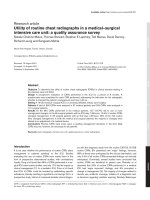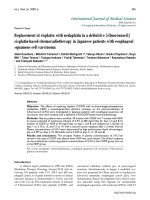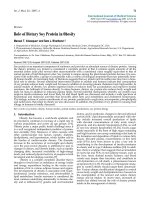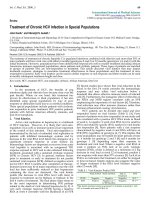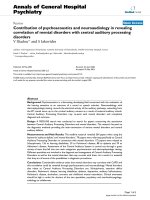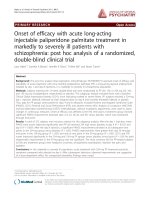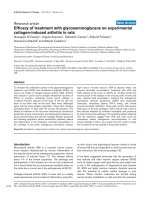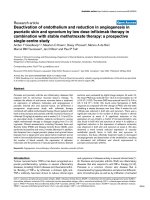Báo cáo y học: "Replacement of cisplatin with nedaplatin in a definitive 5-fluorouracil/ cisplatin-based chemoradiotherapy in Japanese patients with esophageal squamous cell carcinoma"
Bạn đang xem bản rút gọn của tài liệu. Xem và tải ngay bản đầy đủ của tài liệu tại đây (477.12 KB, 7 trang )
Int. J. Med. Sci. 2009, 6
305
I
I
n
n
t
t
e
e
r
r
n
n
a
a
t
t
i
i
o
o
n
n
a
a
l
l
J
J
o
o
u
u
r
r
n
n
a
a
l
l
o
o
f
f
M
M
e
e
d
d
i
i
c
c
a
a
l
l
S
S
c
c
i
i
e
e
n
n
c
c
e
e
s
s
2009; 6(6):305-311
© Ivyspring International Publisher. All rights reserved
Research Paper
Replacement of cisplatin with nedaplatin in a definitive 5-fluorouracil/
cisplatin-based chemoradiotherapy in Japanese patients with esophageal
squamous cell carcinoma
Akiko Kuwahara
1
, Motohiro Yamamori
2
, Kohshi Nishiguchi
3,4
, Tatsuya Okuno
3
, Naoko Chayahara
3
, Ikuya
Miki
3
, Takao Tamura
3
, Tsubasa Inokuma
2
, Yoshiji Takemoto
2
, Tsutomu Nakamura
3
, Kazusaburo Kataoka
1
and Toshiyuki Sakaeda
2,3
1. School of Pharmacy and Pharmaceutical Sciences, Mukogawa Women’s University, Nishinomiya, Japan;
2. Graduate School of Pharmaceutical Sciences, Kyoto University, Kyoto, Japan;
3. Kobe University Graduate School of Medicine, Kobe, Japan;
4. Faculty of Pharmaceutical Sciences, Kyoto Pharmaceutical University, Kyoto, Japan
Correspondence to: Toshiyuki Sakaeda, Ph.D., Center for Integrative Education of Pharmacy Frontier (Frontier Education
Center), Graduate School of Pharmaceutical Sciences, Kyoto University 46-29 Yoshidashimoadachi-cho, Sakyo-ku, Kyoto
606-8501, Japan. Tel: +81-75-753-9560, Fax: +81-75-753-4502, E-Mail:
Rec
eived: 2009.06.23; Accepted: 2009.09.25; Published: 2009.09.28
Abstract
Objective: The effects of replacing cisplatin (CDDP) with cis-diammineglycolatoplatinum
(nedaplatin, NDP), a second-generation platinum complex, on the pharmacokinetics of
5-fluorouracil (5-FU) were investigated in Japanese patients with esophageal squamous cell
carcinoma, who were treated with a definitive 5-FU/CDDP-based chemoradiotherapy.
Methods: Fifty-six patients were enrolled, 49 treated with CDDP and 7 treated with NDP.
A course consisted of continuous infusion of 5-FU at 400 mg/m
2
/day for days 1-5 and 8-12,
infusion of CDDP or NDP at 40 mg/m
2
/day on days 1 and 8, and radiation at 2 Gy/day on
days 1 to 5, 8 to 12, and 15 to 19, with a second course repeated after a 2-week interval.
Plasma concentrations of 5-FU were determined by high performance liquid chromatogra-
phy at 5 PM on days 3, 10, 38 and45, and at 5 AM on days 4, 11, 39 and 46.
Results and conclusions: The circadian rhythm in plasma concentrations of 5-FU ob-
served in the case of CDDP was altered when NDP was used instead. The clinical response
can be predicted by monitoring plasma concentrations of 5-FU in the CDDP group, but not
in the NDP group.
Key words: nedaplatin, chemoradiotherapy, esophageal squamous cell carcinoma, 5-fluorouracil,
plasma concentration
Introduction
A clinical report published in 1999, the RTOG
(Radiation Therapy Oncology Group) 85-01 trial in-
volving 134 patients with T1-3, N0-1 and M0 eso-
phageal cancer, is of great interest in terms of clinical
outcome because it demonstrated a 5-year survival
rate of 26 % [1-4]. This treatment consists of infusion
of 5-fluorouracil (5-FU) and cisplatin (CDDP), and
concurrent radiation, without pre- or post-surgical
resection. Simultaneously in Japan, a modified ver-
sion was proposed by Ohtsu and his co-workers for
advanced metastatic esophageal cancer [5,6]. Two
independent clinical investigations have shown cura-
tive potential using this regimen for unresectable
esophageal squamous cell carcinoma (ESCC) with T4
Int. J. Med. Sci. 2009, 6
306
or M1a [5,6]. A long-term evaluation of efficacy and
toxicity with 139 patients resulted in a complete re-
sponse (CR) rate of 56%, along with a 5-year survival
rate of 29% [7-9]. Currently, a definitive
5-FU/CDDP-based chemoradiotherapy (CRT) is rec-
ognized as one of the most promising treatments for
esophageal cancer [10].
A series of studies has been performed to find a
marker predictive of clinical outcome after treatment
with a definitive 5-FU/CDDP-based CRT [11-13]. A
total of 8 measurements of the plasma concentration
of 5-FU were made per patient, and it was concluded
that the average value was predictive of clinical re-
sponse, but not of severe acute leucopenia, stomatitis
and cheilitis. Additionally, it has been suggested that
clinical response and severe acute toxicities may be
predicted on the basis of genetic polymorphisms.
CDDP is one of the antitumor agents most
widely used against several types of solid tumors.
However, its clinical use is limited by its potent
nephrotoxicity, which can lead to acute renal failure.
Nedaplatin (NDP), cis-diammineglycolatoplatinum, is
a second-generation platinum complex that is ap-
proximately 10 times as soluble in water as CDDP
[14-16]. As such, NDP is considered to have more
pronounced activity against solid tumors, but less
nephrotoxicity and gastrointestinal toxicity than
CDDP [14]. In phase II clinical studies, NDP was
found to be highly effective against solid tumors, in-
cluding non-small cell lung cancer, small cell lung
cancer, head and neck cancer and esophageal cancer
[15]. The replacement of CDDP with NDP might be of
value for a certain subpopulation of patients. Al-
though little information is yet available, it was re-
cently reported that NDP was comparable to CDDP
with regards to clinical response and survival, and
also to acute and late toxicity in the treatment of
ESCC [16]. In this study, the effects of replacing
CDDP with NDP on the pharmacokinetics of 5-FU
were investigated in ESCC patients treated with a
definitive 5-FU/CDDP-based CRT.
Patients and Methods
Patients
Fifty-six ESCC patients were enrolled in this
study based on the following criteria: 1) ESCC treated
at Kobe University Hospital from August 2002 to
June 2006; 2) clinical stage T1 to T4, N0 or N1, and M0
or M1a according to the International Union Against
Cancer tumor node metastasis (TNM) classification;
3) age less than 85 years; 4) an Eastern Cooperative
Oncology Group performance status of 0 to 2; 5) ade-
quate bone marrow, marrow, renal, and hepatic
function; 6) no prior chemotherapy; 7) no severe
medical complications; and 8) no other active
malignancies (except early cancer). The tumors were
histologically confirmed to be primary, and no pa-
tients with recurrence were included in this study.
Protocol
The protocol is presented in Figure 1. A course
consisted of continuous infusion of 5-FU at 400
mg/m
2
/day for days 1-5 and 8-12, infusion of CDDP
or NDP at 40 mg/m
2
/day on days 1 and 8, and radia-
tion at 2 Gy/day on days 1 to 5, 8 to 12, and 15 to 19,
with a second course repeated after a 2-week interval
[5,6]. If disease progression/recurrence was ob-
served, either salvage surgery, endoscopic treatment,
or another regimen of chemotherapy was scheduled.
Forty-nine of 56 patients were treated with CDDP
(the CDDP group), and the remaining 7 patients were
treated with NDP (the NDP group). This study was
conducted with the authorization of the institutional
review board and followed the medical research
council guidelines of Kobe University.
Figure 1. Protocol of a definitive
5-fluorouracil (5-FU)/ cisplatin (CDDP)
or nedaplatin (NDP)-based chemora-
diotherapy. One course of treatment
consisted of protracted venous infusions
of 5-FU (400 mg/m
2
/day for days 1-5 and
8-12) and CDDP (or NDP) (40
mg/m
2
/day on days 1 and 8), and radia-
tion (2 Gy/day on days 1-5, 8-12, and
15-19), with a second course (days
36-56) was repeated after a 2-week
interval.
Int. J. Med. Sci. 2009, 6
307
Pharmacokinetics of 5-FU
Aliquots (5 mL) of blood were collected into
etylenediaminetetraacetic acid-treated tubes at 5 PM
on days 3, 10, 38 and 45, and at 5 AM on days 4, 11, 39
and 46 [11-13]. The plasma concentration of 5-FU was
determined by high-performance liquid chromatog-
raphy as described previously [11-13]. The apparent
elimination half-life of 5-FU is approximately 10 min-
utes [17], and the plasma concentration will reach a
steady-state within a few hours of starting continuous
infusion. The systemic exposure to 5-FU during each
of 4 cycles was assessed as the area under the con-
centration time curve for 120 hours (AUC
120h
), calcu-
lated as 120 hours x the average of 2 measurements
within a cycle.
Clinical Response
A CR was defined as the complete disappear-
ance of all measurable and assessable disease at the
first evaluation, which was performed 1 month after
the completion of CRT to determine whether the dis-
ease had progressed. The clinical response was
evaluated by endoscopy and chest and abdominal
computed tomography (CT) scans in each course. A
CR at the primary site was evaluated by endoscopic
examination when all of the following criteria were
satisfied on observation of the entire esophagus: 1)
disappearance of the tumor lesion; 2) disappearance
of ulceration (slough); and 3) absence of cancer cells
in biopsy specimens. If small nodes of 1 cm or less
were detected on CT scans, the recovery was defined
as an “uncertain CR” after confirmation of no pro-
gression for at least 3 months. An “uncertain CR” was
included as a CR when calculating the CR rate. When
these criteria were not satisfied, a non-CR was as-
signed. The existence of erosion, a granular pro-
truded lesion, an ulcer scar, and 1.2 w/v% io-
dine/glycerin-voiding lesions did not prevent an
evaluation of CR. The evaluations were performed
every month for the first 3 months, and when the cri-
teria for CR were not satisfied at 3 months, the result
was changed to non-CR. Follow-up evaluations were
performed thereafter every 3 months for 3 years by
endoscopy and CT scan. After 3 years, patients were
seen every 6 months. During the follow-up period, a
routine course of physical examinations and clinical
laboratory tests was performed to check the patient’s
health.
Severe Acute Toxicities
A definitive 5-FU/CDDP-based CRT is associ-
ated with acute toxicities, predominantly leucopenia,
stomatitis, and cheilitis [5-9,18]. Toxicity was evalu-
ated using criteria defined by the Japan Clinical On-
cology Group [19].
These criteria were based on the
National Cancer Institute Common Toxicity Criteria.
Toxicity was assessed on a 2 to 3 day basis during the
CRT and subsequent hospitalization period and on
every visit after the completion of CRT. Episodes of
leucopenia, stomatitis, and cheilitis during the first 2
courses and subsequent 2 weeks (until day 70) were
recorded as acute toxicities and those of grade 3 or
more as severe acute toxicities.
Data Analysis and Statistics
All values reported are the mean±standard de-
viation (SD). The association of disease stage with the
rates of CR and severe acute toxicities were analyzed
with Fisher’s exact test. Circadian variations of
plasma concentrations of 5-FU were analyzed with
the Wilcoxon signed-rank test. The unpaired Stu-
dent’s t-test/Welch’s test or Mann-Whitney’s U test
was used for two-group comparisons of the plasma
concentrations or AUC
120h
values of 5-FU. P values of
less than 0.05 (two tailed) were considered to be sig-
nificant.
Results
Demographic and clinicopathologic characteris-
tics of 56 ESCC patients are summarized in Table 1.
The ratio of T1/T2/T3/T4 was 17/6/21/12, that of
N0/N1 was 23/33, and that of M0/M1a was 45/11,
resulting in a stage I/II/III/IVa ratio of 13/10/22/11.
There was no significant difference between the 2
groups; the CDDP group (N=49) and the NDP group
(N=7).
The results of clinical outcome are summarized
in Table 2. The overall CR rate was 44.6%, and de-
pended on disease stage; 84.6%, 70.0%, 27.3% and
9.1% for stage I, II, III and IVa, respectively (P<0.05).
NDP was comparable to CDDP with respect to clini-
cal response, but the treatment with NDP achieved a
CR at stage IVa (data not shown). Episodes of severe
acute leucopenia, stomatitis and cheilitis occurred in
42.9%, 12.5% and 14.3% of cases, respectively, and
each rate was independent of disease stage (data not
shown). Replacement of CDDP with NDP had no ef-
fect on the rates of these severe acute toxicities (data
not shown).
Int. J. Med. Sci. 2009, 6
308
Table 1. Demographic and Clinicopathologic Characteristics of 56 Japanese Patients with Esophageal Squamous Cell
Carcinoma
Characteristics Values
Age, yr 64.3±7.5 (48 -78)
Height, cm 163.1±6.7 (150-180)
Weight, kg 55.9±9.4 (33-79)
Sex Male/Female = 51/5
Race Japanese
Performance status 0/1/2/unknown = 28/22/4/2
Histological type squamous cell carcinoma
Differentiation well/moderate/poor/unknown = 8/31/9/8
T1/T2/T3/T4 = 17/6/21/12
N0/N1 = 23/33
TNM score
M0/M1a = 45/11
Stage I/II/III/IVa = 13/10/22/11
The values are the mean±SD, with the range in parentheses. TNM score: tumor, node, metastasis. Patients with noncervical primary tumors
with positive supraclavicular lymph nodes were defined as M1a.
Table 2. Clinical Outcome in 56 Japanese Patients with Esophageal Squamous Cell Carcinoma
N %
Clinical Response
Complete response (CR) rate 25 44.6
Partial response (PR) rate 24 42.9
Severe Acute Toxicities
Leucopenia 24 42.9
Stomatitis 7 12.5
Cheilitis
8
14.3
The plasma concentrations of 5-FU are shown in
Figure 2. The values of AUC
120h
are summarized in
Table 3. In the 1st cycle/1st course, plasma concen-
trations of 5-FU were significantly lower at 5 AM
(0.076±0.040 μg/mL) than at 5 PM (0.109±0.060
μg/mL) in the CDDP group (P<0.05, β=0.907). A
similar tendency was observed in the 2nd cycle/1st
course (P=0.134, β=0.390). In the NDP group, how-
ever, concentrations tended to be higher at 5 AM than
at 5 PM in both the 1st and 2nd cycle/1st course
(P=0.249, β=0.106, P=0.463, β=0.138, respectively),
whereas the AUC
120h
value of 5-FU in the CDDP
group was almost the same as that in the NDP group
in the 1st as well as 2nd cycle/1st course (Table 3). In
the 1st course, the plasma concentrations of 5-FU at
both 5 PM and 5 AM were significantly higher in the
2nd cycle than the 1st cycle in the CDDP group
(P<0.05, β=0.951, P<0.05, β=0.999, respectively).
Similarly in the NDP group, the concentration of
5-FU tented to increase in the 2nd cycle, but not sig-
nificantly (P=0.116, β=0.205, P=0.173, β=0.211, respec-
tively). These phenomena found in the 1st course
were also found in the 2nd course, for both groups.
The correlation between the CR rate and the
plasma concentration of 5-FU was evaluated, and the
results obtained with the average value of 8 meas-
urements are summarized in Table 4. In the CDDP
group, the plasma concentrations of 5-FU were sig-
nificantly higher in the patients with CR than those
with non-CR (P<0.05), but the inclusion of 7 patients
treated with NDP resulted in no statistically signifi-
cant difference (P=0.090). The association with severe
acute toxicities was also evaluated, and the results on
leucopenia are summarized in Table 5. There was no
difference in the plasma concentrations of 5-FU be-
tween the patients with and without severe acute
leucopenia, in either groups. Similarly, the plasma
concentrations of 5-FU in the patients with severe
acute stomatitis or cheilitis were comparable to those
in the patients without (data not shown).
Int. J. Med. Sci. 2009, 6
309
Table 3. Area Under the Concentration-Time Curve Values (AUC
120h
, mg*h/L) of 5-Fluorouracil (5-FU) in 56 Japanese
Patients with Esophageal Squamous Cell Carcinoma
CDDP NDP
N=49 N=7
1st cycle / 1st course 11.1±4.8 11.0±4.6
2nd cycle / 1st course 16.8±6.4 15.3±7.3
1st cycle / 2nd course 10.7±5.2 10.6±4.4
2nd cycle / 2nd course
16.0±5.4
15.9±6.8
CDDP: cisplatin, NDP: nedaplatin. Systemic exposure to 5-FU was assessed as the AUC
120h
, calculated as 120 hours x the average of 2 meas-
urements. There was no significant difference between the 2 groups at each of the 4 cycles.
Table 4. Plasma Concentrations of 5-Fluorouracil (5-FU) in the Patients with and without a Complete Response (CR).
CR
non-CR
N 5-FU, μg/mL N 5-FU, μg/mL P
CDDP
23
0.124±0.035
26
0.105±0.044
0.045
NDP 2 0.078 , 0.117 5 0.116±0.038 -
total
25
0.122±0.035
31
0.107±0.043
0.090
CDDP: cisplatin, NDP: nedaplatin. The average of 8 measurements made per patient is listed as the data. In the CDDP group, plasma con-
centrations of 5-FU were significantly higher in the patients with CR than those without (non-CR), but the inclusion of 7 patients treated with
NDP resulted in no significant differences.
Table 5. Plasma Concentrations of 5-Fluorouracil (5-FU) in the Patients with and without Severe Acute Leucopenia.
Severe Acute Leucopenia No Severe Acute Leucopenia
N
5-FU, μg/mL
N
5-FU, μg/mL
P
CDDP 21 0.116±0.036 28 0.113±0.033 0.785
NDP 3 0.114±0.053 4 0.109±0.021 0.869
total 24 0.115±0.037 32
0.112±0.031 0.746
CDDP: cisplatin, NDP: nedaplatin. The average of 8 measurements made per patient is listed as the data. There was no difference between
the patients with and without severe acute leucopenia, in either group.
Figure 2. Plasma concentrations
of 5-fluorouracil (5-FU) in 56 pa-
tients with esophageal cancer. A
total of 8 measurements were
made per patient: 5 PM on days 3,
10, 38 and45, and 5 AM on days 4,
11, 39 and 46. Closed circle: the
cisplatin (CDDP) group (N=49),
open circle: the nedaplatin (NDP)
group (N=7). The bars represent
the SD. * P<0.05; significant dif-
ferences were observed in the
CDDP group, but not in the NDP
group.

